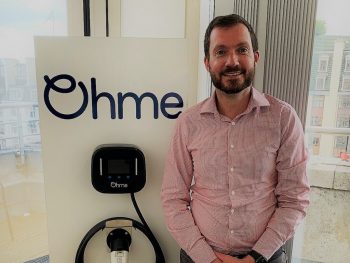Comment: Ohme insights on driving EV efficiency
Ohme mobility director Peter McDonald looks at the different ways of measuring efficiency – including the new definition that EV fleets should be paying attention to.

Ohme mobility director Peter McDonald
Efficiency comes in many shapes and forms for fleet managers running a fleet of EVs. But while it’s easy to focus on what traditional forms that efficiency comes in, it’s also good to take a look at the wider picture that comes with EVs and electric LCVs too.
Driving efficiency
The term ‘driving efficiency’ will be nothing new for fleet managers – we’ve been talking about it for years with ICE vehicles. In reality, it’s no different with EVs – and arguably even more important. The same skills that help a fleet’s drivers to pilot an ICE vehicle efficiently are just as true for those driving EVs and, with regenerative braking as well, developing and improving those skills of reading the road ahead are more crucial with an EV.
Fleet driver training companies have developed EV-specific courses exactly for those reasons. Even experienced EV drivers wouldn’t question that there’s a learning curve when switching from ICE to EV.
Driver training enables newcomers to learn how best to use regenerative braking, the different levels and types of charging and how to get the most from their vehicles generally – particularly when driving in winter and the range may be reduced. The more efficient the driver, the better their range will be and the more time you get back to the driver and your company.
It’s also worth considering your sat nav systems too. Famously, many years ago some companies such as UPS moved to a different routing system on their sat nav programming to ensure that vehicles avoided turning through oncoming traffic if possible (so a right turn in the UK) to avoid the risk of a collision and also to save fuel by not lengthening that waiting time. Is that fuel saving element still relevant with an EV? It’s a question that fleet managers will have to find out.
Charging and working efficiency
It goes without saying that the cheapest place to charge an EV is always at home. For some fleets, that means fitting a charger at their driver’s home and using the likes of Ohme’s technology to help automatically provide that charging data to their fleet manager. That way, the driver gets the benefit of having a charger at their home and the fleet manager gets the benefit of reduced-cost charging.
Ultimately, it comes down to time. As I said earlier, the easier it is for your drivers to charge, or even charge at their home and start the day with a fully charged battery, then the less downtime they’ll have and the more efficient they’ll be for the business.
While there is obviously an extra cost to the company of fitting chargers at the homes of employees, if that charging convenience even reduces employee downtime by one hour a week (not an unrealistic amount), then the charger could pay for itself in as little as 10-12 weeks. I’ll tackle this subject in more detail in a future column.
At Ohme, we have numerous corporate arrangements with fleets and fleet providers to do exactly that, to help make that transition to e-mobility as smooth as possible for the fleet managers and drivers alike. Such are the big cost differences between public charging and home charging (with VAT rates alone), that a fleet manager could even potentially look at incentivising drivers to charge at home and still be better off.
Public perception
If fitting a home charger isn’t possible, fleet managers need to make public charging easy to utilise for their drivers. Ideally, that means access to a number of charging points through an all-in-one style charge account such as those on offer in the market. However it is done though, the easier it is for your drivers to charge whether on the road or at home, then the happier and more efficient your fleet and its users will be.
The same goes for those charging costs. With Ohme’s relationships and software linking with others such as TMC, charging data can be quickly and automatically filed, saving both the fleet manager and the driver time. It also gives the fleet manager immediate data on their charging costs, the CO₂ of their fleet and enables them to make rapid decisions such as how much to reimburse the driver.
Overall though, all of these factors have to be taken into account and, with familiarity, fleet managers will find more efficiency savings as they continue in their switch from ICE to electric vehicles. And the earlier that this switch is made, then the earlier they will be able to start making those savings and find those efficiencies for their fleet.
Peter McDonald is mobility director at Ohme. Prior to his current role, he spent two decades working for automotive manufacturers including Nissan, SEAT and the wider Volkswagen Group.












